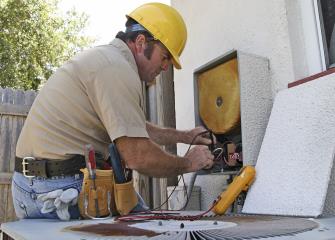
A property management LLC can be described as a limited-liability company. The LLC legal structure offers many benefits for business owners. These include asset security and pass-through income taxation. There are many types, but all share the same goal to limit your liabilities.
You can create an LLC to seperate your personal assets and the real estate that you manage. You will also be able to reduce the paperwork required. An LLC is a great option for renting your property. It will protect you from lawsuits.
An LLC is not an easy way to manage your rental property. An LLC must be set up in your state. Then, your deed will be transferred to the new LLC. Finally, the LLC should open a bank Account. A small setup fee will be required.

Once you have this done, you will be able to transfer any profits or losses that you make from your rental property into your LLC. If you make a lot of money from renting your property, you can use the money to pay off your mortgage. Taxes will apply to the income from your property. If you manage multiple properties, it is a smart idea to set up an LLC to protect your assets.
Another benefit of forming an LLC is the ability to maintain your anonymity. It is easier for your tenant to find you if your name is different from your personal. A LLC will also allow you to rent your property to residential tenants.
It is a good idea in the case of a property manager business to have an operating agreement written. These agreements detail the duties of each member of the LLC. These agreements should also contain information about cancellation and termination policies. The fees, responsibilities, and services of each member are all important to be covered in an agreement.
You can get the most from an LLC by choosing a name that is appropriate. It should be unique to your local area, but easy to remember. If the LLC is a multi-member entity, it can be a good idea to keep the address of the property a secret.

While it might seem like an unnecessary expense you will be able to save both time and cash by creating an LLC. Instead of filing dozens of tax returns, and paying thousands in corporate fees and filing them all, an LLC will only require you to file one or two returns and pay the taxes on the profits.
You should be familiar with what you're doing when you form an LLC. Research is essential for any business. There are many different types of LLCs. Make sure you choose the one that suits you best. Also, consult a lawyer. Smart attorneys can help you to find loopholes and prevent any claims against your.
FAQ
What is the best time to hire a handyman for your project?
There isn't really a "right" time to hire a handyman. You simply need to get started as soon as possible. Of course, you can wait until after the holidays to save some money. But you could also just pick up the phone and call around to different handymen.
What are the most frequent handyman repairs that you need to make?
Handymen often repair roofs, windows and doors, doors, gutters. Decks, fences and sheds are all common repairs. Handymen are available to help homeowners with home improvements and building projects. They can also assist with plumbing, painting, drywall, landscaping, concrete work as well as tiling and decking.
What time does it take for a handyman finish a job?
It all depends upon the size of your project. The time it takes to finish smaller projects is more common than larger ones. A handyman can usually finish a project in one week, regardless of its size.
What training do I need to give a handyman in order to do my job?
No. Handymen have all the skills and knowledge necessary to complete any task. You only need to provide the materials needed to complete the task.
Is it worthwhile to spend more money on professional handyman services?
It depends entirely on the project. For complex projects, such as an office renovation or construction project, a professional handyman would be a great option.
Statistics
- More than 20% of homes in America have outdoor living spaces, including decks and patios. (mrhandyman.com)
- With a strong housing market, the handyman and general maintenance worker industry are expected to grow by nearly 10% in the next decade. (housecallpro.com)
- A franchise was approximately $110,000 with a franchise fee of $14,900, according to a spokesperson for a national handyman franchise. (en.wikipedia.org)
- An estimate was that in 2003, the market for home maintenance and repair spending was up 14% 2001 to 2003. (en.wikipedia.org)
- “Before the pandemic, 40% of people asked how we could estimate a job when we weren't there,” Rose recalled. (inquirer.com)
External Links
How To
How to replace a broken tile
Step 1: Take away the old tiles.
Remove the old tiles from your flooring and put them aside. You'll want to keep these intact if you use them later. Note which pieces are missing or damaged to avoid having to search for replacements.
Step 2 – Choose New Tiles
You can take a look at the different options for tile replacement.
-
You can find a tile replacement that is similar to the one you have just removed.
-
To find the matching piece, use the measurements that you took while removing the tile. This allows you to easily find the perfect size without needing to measure again.
-
Be open to different colors, patterns or textures.
-
Consider which grout you would like to use, if any. Some people prefer solid color; others enjoy mixing it up.
-
It is important to ensure that the tile you choose resists moisture.
-
Consider the location of your tile. You can save both time and money by making sure that there is enough room for proper installation.
-
Once you've found the tile that suits your needs, you can place your order online.
Step 3 - Place the tiles.
To install your tiles, follow the same procedure as before. It is important to align them correctly so they fit together properly.
Step 4: Clean Up
Make sure to clean up all debris and other materials before applying the final layer of protection material.
This will keep dust and dirt from getting into the grout between tiles, which could lead to mold.
Step 5 - Sand Down the Floor
After you have cleaned everything, sand the floor to remove any particles that were left from the previous step.
Step 6 -- Finish Off
After the floor has been smoothed, you can apply protective coatings to the tiles. Wait until the floor is completely smooth before applying the protective coatings to the tiles. Wet paint could stain the tiles' surface.
To protect your floors from stains, you can use "damp-and dry" products.
It won't solve every problem after your tiles are installed. For example, if you have a lot of kids running around, you may want to consider using an anti-slip coating on top of the protective layer.
And finally, remember to leave the protective sealer on for several weeks before moving back into your home.